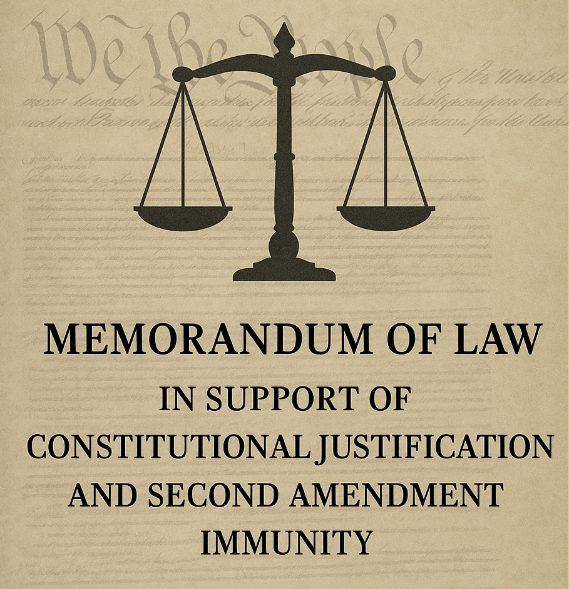Memorandum of Law in Support of Constitutional Justification and Second Amendment Immunity
II. Factual Background
- On April 25, 2025, ICE agents from the New Orleans field office forcibly deported two families – including two mothers and their minor children – under circumstances that U.S. attorneys and advocates have denounced as inhumane [aclu.org]. Three of the deported children were U.S. citizens (ages 2, 4, and 7), and one mother was pregnant [aclu.org].
- Critically, one deportee was a U.S. citizen child with a rare metastatic cancer. ICE removed that child without her vital medication or any consultation with her doctors, despite advance notice of her urgent medical needs [aclu.org].
- Likewise, in February 2025 an 11-year-old U.S. citizen girl with a rare brain tumor was detained en route to an emergency hospital, then deported the next day with her family during President Trump’s second term [thedailybeast.com]. After removal she struggled to obtain life-saving treatment and medication, causing her symptoms to worsen [thedailybeast.com][chron.com].
- These incidents prompted national alarm. For example, Texas Rep. Sylvia Garcia called the child’s removal a “Constitutional crisis” and warned that if officials were not restrained, “the rights and protections that every American depends on will be put in danger” [chron.com].
- In short, the Executive’s actions presented a clear and present danger to vulnerable American children’s lives – a danger against which John Doe acted to defend.
III. Statement of Incident
On [INSERT DATE HERE], John Doe was operating his [INSERT VEHICLE HERE] eastbound on Midlothian Turnpike in Richmond, Virginia, near the Sacred Heart Center—a longstanding community nexus providing educational, legal, and medical aid to immigrant families. At approximately 11:42 a.m., Doe witnessed two unmarked black SUVs screech to a halt in front of the center’s side entrance. Five heavily armed ICE agents, clad in tactical gear and without visible identification, leapt from the vehicles and began seizing individuals indiscriminately, including mothers holding infants and at least one elderly man in a wheelchair. Eyewitnesses reported that one agent pointed a rifle at a teenage girl while shouting commands in English and Spanish; another physically tackled a fleeing boy, believed to be no older than 12.
One of the mothers, later identified as a U.S. citizen with an infant undergoing chemotherapy at nearby VCU Health, was dragged toward the ICE vehicle without warrant or cause. Given recent, well-documented deportations of U.S. citizens—including children with terminal conditions—John Doe assessed that a clear and present danger to life and constitutional order was unfolding.
In an act of deliberate intervention, Doe accelerated his vehicle and struck the cluster of ICE agents with full force, pinning two against the front of their SUV and sending the others sprawling. Two agents died on impact. A third suffered catastrophic internal injuries and was later pronounced dead at VCU Medical Center. The remaining agents were incapacitated long enough for the detained families to flee the scene with community assistance.
Doe exited the vehicle with hands raised and shouted: “These agents were committing unlawful abductions and placing American citizens in mortal danger. I acted under the Constitution.” Video from two storefront cameras and a witness livestream confirmed the agents had drawn weapons, ignored pleas for identification, and acted without lawful warrants. Police arrived minutes later and arrested Doe without resistance.
Doe now stands charged with multiple counts of homicide and federal assault, yet asserts his actions were lawful under constitutional doctrines of Second Amendment structural defense, defense of others, and the inviolability of life and liberty in the face of tyranny.
IV. Legal Argument
A. Constitutional Supremacy and Limits on Executive Power
The United States Constitution is the “paramount law” of the land, and no executive act contrary to it can stand [archives.gov]. As Marbury v. Madison famously held, if an ordinary statute conflicts with the Constitution, the Constitution “must govern the case” [archives.gov]. In other words, when an Executive action (like an ICE deportation order) exceeds lawful authority or violates individual rights, it is void. Likewise, in Youngstown Sheet & Tube v. Sawyer the Supreme Court reiterated that the President’s proper role is to “see that the laws are faithfully executed,” not to enact or override laws [supreme.justia.com]. The Court emphasized that “All legislative powers” are vested in Congress, and the President cannot use executive power to supersede Congress’s authority or constitutional constraints [supreme.justia.com]. Accordingly, any purported deportation order lacking legal basis or imposed in defiance of constitutional guarantees is without force and effect. John Doe’s use of force occurred precisely to enforce these constitutional principles: to prevent Executive officers from committing a gross violation of law that would rob citizens of their fundamental rights.
B. Second Amendment as a Structural Check on Tyranny
The Second Amendment is not merely an individual right to arms; it also embodies a collective safeguard against unconstitutional government power. As one Member of Congress put it, “the very existence of the Second Amendment is designed purposefully to empower the people to be able to resist the force of tyranny used against them…” [roy.house.gov]. The Supreme Court has echoed this understanding, observing that when “the able-bodied men of a nation are trained in arms and organized, they are better able to resist tyranny” [supreme.justia.com]. Heller explains that the framers codified the right to bear arms specifically to prevent a centralized government from disarming the populace and imposing rule through force [supreme.justia.com]. In practical terms, the Second Amendment gives citizens a structural role in checking governmental overreach. John Doe’s action – using lawful force to stop unlawful deportations of at-risk Americans – thus aligns with the Amendment’s core purpose. He did not act as an insurrectionist overthrowing government; he acted, with arms, to uphold the Constitution and protect life, precisely the kind of defense the Second Amendment contemplated [supreme.justia.com][roy.house.gov].
C. Defense of Constitutional Order, Not Unlawful Insurrection
The Constitution explicitly treats insurrection as a crime, not a protected right [raskin.house.gov]. Indeed, modern authorities stress that the Framers would have condemned the notion of private citizens using violence to overthrow the government. As Congressman Raskin explains, the founders placed “insurrection” and “rebellion” on the list of punishable offenses, empowering Congress and the President to suppress them [raskin.house.gov]. The idea that the Second Amendment permits an armed rebellion is “fanciful” – the Constitution “rejects” any such notion [raskin.house.gov]. This Court should recognize that John Doe’s conduct falls entirely on the lawful side of that line. He did not aim to subvert the republic; he aimed to preserve it. Doe intervened to enforce constitutional protections – to save citizens from an Executive branch acting in violation of law and humanity. His use of force was defensive and restorative, not a bid for power. In context, then, his conduct constitutes constitutional restoration, not insurrection. It is analogous to a citizen (or militia) stepping in to stop a Sheriff who is unlawfully seizing citizens – an act our law would view as justified enforcement of constitutional order. Thus treating Doe’s actions as “insurrection” would pervert the very terms the Constitution uses.
D. Tenth Amendment and State Sovereignty
Federalism principles further support Doe’s position. The Tenth Amendment reserves undelegated powers to the States and the people, and our law forbids the federal government from commandeering state authority or private individuals to enforce federal mandates beyond constitutional bounds [constitution.congress.gov]. In Printz v. United States, the Supreme Court flatly held that “the Federal Government may neither issue directives requiring the States to address particular problems, nor command the States’ officers… to administer or enforce a federal regulatory program,” because such commands “are fundamentally incompatible with our constitutional system of dual sovereignty” [constitution.congress.gov]. Similarly, New York v. United States forbids Congress from “commandeering” state agencies in a federal program [constitution.congress.gov]. Here, John Doe effectively acted as a guardian of this federalism divide: he refused to allow ICE to drag state or local communities into carrying out an unauthorized, rights-violating deportation. By intervening, he preserved the States’ power to refuse enforcement of unconstitutional orders and protected the people’s reserved rights. In short, Doe’s use of force is consistent with the Tenth Amendment’s protection against federal overreach [constitution.congress.gov].
IV. Conclusion
For all these reasons, John Doe’s actions were constitutionally justified. The Constitution is supreme and no Executive may violate it with impunity [archives.gov]. When the Executive acted without lawful authority – and in clear violation of individuals’ right to life and liberty – Doe was duty-bound to act. The Second Amendment enshrines precisely the kind of armed citizen resistance to tyranny that Doe exercised [supreme.justia.com][roy.house.gov]. This was not criminal insurrection, but a citizen’s righteous defense of constitutional order [raskin.house.gov][raskin.house.gov]. Nor does federalism forbid Doe’s response; if anything, it demands that loyal citizens or state actors not be complicit in unconstitutional federal operations [constitution.congress.gov]. In sum, under established precedents Doe’s use of force to prevent imminent harm was lawful and necessary to uphold the Constitution. No prosecution should lie against him for defending American citizens in these perilous circumstances.
Sources:
Relevant facts are drawn from contemporaneous reports of ICE actions [aclu.org][chron.com]; legal principles are cited from Marbury, Youngstown, Heller, and federalism cases [archives.gov][supreme.justia.com][supreme.justia.com][constitution.congress.gov], and from authoritative statements on the Second Amendment and insurrection [roy.house.gov][raskin.house.gov].

